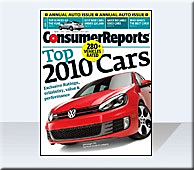If the latest survey from Consumer Reports is accurate, 73% of car buyers said they were “somewhat” or “very likely” to purchase the same make they currently drive the next time they shop for a new car.
However, if they were to change brands, most respondents said that higher quality, better fuel economy, and a lower price are the three biggest factors that would influence their decision. There seems to be a return to pragmatism in people’s minds.
“A buyer’s attachment to a brand, for example, can vary significantly by gender and age,” said Jeff Bartlett, Deputy Editor Online, Consumer Reports Cars. “Possible reasons younger drivers could be influenced more readily include changing lifestyles, less experience with a given brand, greater peer influence, and being more trend-conscious.”
Women are notably more likely to be brand loyal than men, with 54% compared to 43% claiming they are “very likely” to purchase another car of the same make as they currently own. The same applies for older drivers. Among drivers 35 and older, at least 50% plan to stay with the brand they already own. Only 41% of drivers aged 18 to 34 years old felt the same. CR also found that household income does not play a role in car brand loyalty. Affluent consumers and those of modest means were nearly equal in their attachment to a brand.
Why buyers switch
When presented with 13 potential factors to entice owners to change their brand allegiance, the top choices were clearly higher quality and better fuel economy, as shown in the following list.
The percent of respondents who could be influenced to change car brands based on specific factors – Higher quality: 75%, Better fuel economy: 73%, Lower price: 67%, Better safety record: 65%, More standard equipment: 62%, Better overall reputation: 61%, Lower-cost financing: 57%, Free maintenance: 57%, Generous trade-in allowance: 57%, Bigger cash rebate: 48%, Local dealership reputation: 47%, Better styling: 46%, Convenient dealership location: 37%.
However, men and women weigh those factors differently. Women are most drawn to better fuel economy (76%), a better safety record (72%), and more standard equipment (65%). Men share similar priorities, though the percent of men influenced by these factors was lower.
As with the other demographic groups, quality and fuel economy are the most significant influences for the 18 to 34 year-old segment.
CR claims that by looking at the factors above, it is clear that automakers can have more influence in shaping brand loyalty than dealers. In fact, manufacturers have direct control over all of the factors that influence more than 60% of consumers. A dealer’s influence on the top factors is mostly limited to how they advertise and present a vehicle in the showroom. Where the dealership carries sway is with the other factors, such as its customer-service reputation and financial dealings.
Overall, CR said survey respondents are attracted to the highest quality and most value for the money. However, it is clear that car owners are being pragmatic in their approach to their next new car. The reigning influences are those that can save money up front, at the pump, and in the long run.
These are among the findings from a telephone survey conducted by the Consumer Reports National Research Center using a nationally representative sample. More than 1,700 interviews were completed among adults whose household owns at least one vehicle over April 29-May 3, 2010.


Auto execs who can’t see fit to drive their own cars up to – and over – 150k mi will “never get it”. But car buyers do get it. Its how much life that is left at that point that determines a brands success. Mr Rolls and Mr Royce knew this. But until today’s auto execs learn this simple fact they will surely keep losing market share decade after decade. Maybe the press should learn to focus on this real world reality as well. Instead of getting so giddy about every new hands free gadget that Microsoft and others are so successful into pushing into new cars. What sells new cars? Its simple. It’s how well they keep running after 150k miles.